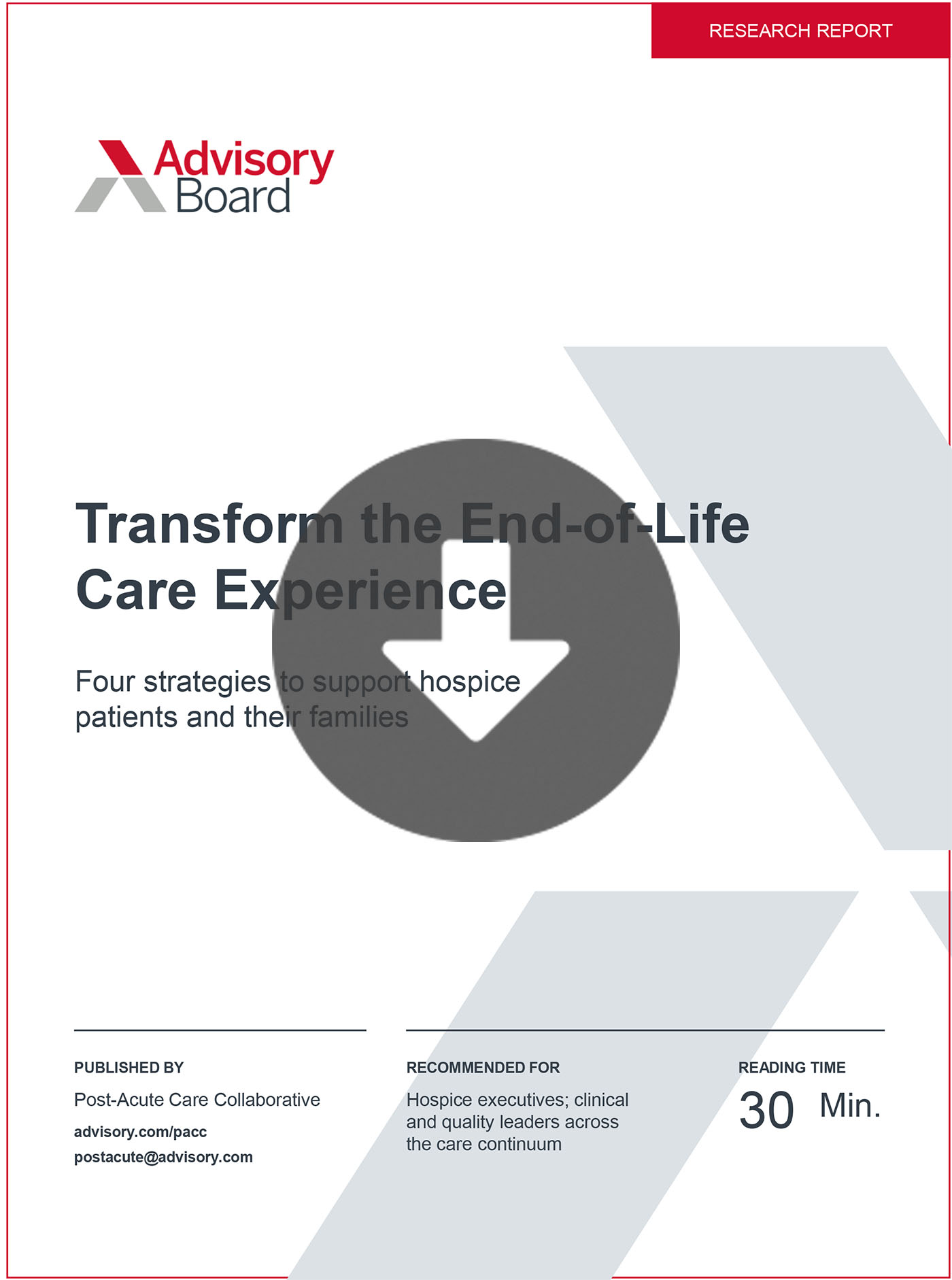Read Advisory Board's take: How leading organizations are improving end-of-life care
Training providers to improve end-of-life communication with patients can help reduce anxiety and depression in patients significantly, according to two studies published last month in JAMA Internal Medicine and JAMA Oncology.
Joanna Paladino, author of the studies and member of the Dana-Farber Cancer Institute's Department of Psychosocial Oncology and Palliative Care, said up to 87% of patients with terminal cancer will have a discussion with their clinicians about end-of-life goals. But more often than not, these conversations take place about one month before death in an acute care setting with a clinician who is not the patient's treating oncologist.
Evaluating the Serious Illness Care Program
That's where the Serious Illness Care Program (SICP) comes in. SICP provides training, coaching, and prompts for oncologists' discussions with patients about end-of-life care, as well as a template for documenting those discussions in the patient's EHR.
In the new studies, researchers put the program to the test. Via randomized control clinical trials, the researchers observed end-of-life discussions between 278 patients with advanced cancer and 91 oncologists just under a four-year period. The JAMA Internal Medicine study looked at whether SICP improved "goal-concordant care, peacefulness, therapeutic alliance, anxiety, and depression," while the JAMA Oncology study looked at whether SICP improved end-of-life conversation EHR documentation.
Findings
After 14 weeks, the researchers found that patients who had been randomly placed into SICP experienced 50% fewer moderate-to-severe anxiety and depression symptoms as the control group of patients. By 24 weeks, anxiety in the SICP group was still lower than the control group, but they were reporting more symptoms of depression than the control group.
The researchers also found that, compared with the control group, patients in SICP were more likely to have their end-of-life discussion documented in an EHR, and those discussions occurred a median of 2.4 months earlier than those in the control group.
In addition to having those conversations earlier, the researchers found the SICP participants' conversations were more comprehensive and patient-centered than those in the control group. According to the studies, SICP participants were more likely to focus on:
- The patient's values and goals;
- Ensuring the patient understood their prognosis or illness; and
- The patient's preferences for life-sustaining treatment.
Of the 91 clinicians who participated in SICP, 98% rated the training as effective.
3 ways to improve end-of-life discussions now
In an editorial, Belinda Kiely and Martin Stockler, researchers from the University of Sydney in Australia, write that while the studies found "no demonstrable effects on the co-primary outcomes (care concordant with goals and peacefulness) or the main secondary outcome, therapeutic alliance," providers should still be "reassured that having these conversations is unlikely to increase anxiety or depression in their patients."
Based on the findings, Kiely and Stockler outlined three ways oncologists can improve end-of-life discussions:
- Initiate end-of-life conversations sooner. "Oncologists should initiate conversations about serious illness with patients who have a significant risk of dying in the foreseeable future," Kiely and Stockler write.
- Learn what matters most to patients. In addition to basic care preferences, Kiely and Stockler write that oncologists should broaden the conversation to learn about the patient's values and priorities in life.
- Ensure end-of-life conversation notes are accessible. Notes from the conversation "should be documented, accessible and flagged in the EHR to increase the accessibility to others involved in the patient's care," Kiely and Stockler write.
Overall, Kiely and Stockler write that oncologists should be having these conversations with their patients not "necessarily because they will improve outcomes, but because patients want, require, and deserve to know what is coming. These conversations should go beyond ceilings of care to include values, priorities, and preferences" (Bean, Becker's Hospital Review, 4/5; Brower, MedPage Today, 4/4).
Advisory Board's take

Deirdre Saulet, Practice Manager, Oncology Roundtable
Improving end-of-life care has been a longstanding priority for health care providers, but many struggle to overcome the numerous cultural and clinical barriers to doing so. For example, only 2% of the oncology board certification exam relates to end-of-life issues. Therefore, it's not surprising that many physicians feel unprepared and uncomfortable broaching end-of-life issues with their patients.
To encourage and support providers in having these discussions, there are three strategies organizations can deploy:
- Identify high-risk patients: Organizations can help providers in identifying which patients are at the highest risk of dying so that they can prioritize conversations with those patients. The simple method of asking doctors, "Would you be surprised if this patient died within the next year?" can be effective. However, given quickly evolving treatments and the human tendency to err on the side of optimism, using data to objectively evaluate patients' risk of mortality is often more reliable.
At the Denver Veterans Administration Medical Center, researchers created prognostic criteria to identify patients with the highest mortality risk. The criteria rely on data that every patient could tell their provider or could easily be extracted from the patient’s chart. Among a hospitalized veteran population, the tool demonstrated 79% sensitivity (rate of correct positive prediction) and 75% specificity (probability of correct negative prediction). These tools are rapidly developing; for instance, researchers at Stanford are now partnering with Google to leverage AI for predicting patients’ risk of mortality for a number of conditions.
“After using the tool, documentation of advanced directives for breast cancer patients have increased from 19% to 81%.”
- Make advance care planning standard for all patients: In 2006, the Institute of Medicine issued a report recommending that every cancer patient receive a care management plan with 13 components, including an advanced care plan. Since then, few—if any—organizations have been able to accomplish this hefty task. But the Oncology Care Model (OCM), which launched in 2016, reemphasized the importance by including IOM care plans as a requirement for participating practices.
UAB Medicine, AtlantiCare, and the USA Mitchell Cancer Center are using treatment planning software, Carevive, to meet this requirement. Using patient-reported and clinical data, the tool alerts them when patients do not have an advance care plan documented. Since using the tool, documentation of advanced directives for breast cancer patients have increased from 19% to 81%.
- Tap into the entire care team: With growing patient panels and a never-ending to-do list, oncologists and other providers benefit from the support of other care team members.
At Gundersen Health System, medical assistants are responsible for identifying patients without advance care plans and flagging them for oncologists. After highlighting the importance of advance care planning, oncologists introduce patients to a social worker, who walks patients through the process and saves the plan in the EHR. After implementing this process, Gundersen saw the percentage of cancer patients with documented advance care plans skyrocket to 60% from 15%.
“After implementing this process, Gundersen saw the percentage of patients with advance care plans skyrocket to 60% from 15%.”
UAB Medicine uses lay and clinical navigators to talk about end-of-life issues with patients. The navigators undergo robust training, including an internal certification course with the directors of palliative care, medicine, and nursing, as well as Gundersen Health System’s online 'Respecting Choices' end-of-life training program. For patients who get the services of a navigator, UAB documented an 18% decrease in costs of care for the last 90 days of life and a 13% increase in hospice use in the last two weeks of life.
To learn more about the four tactics to improve patient care and reduce cost at the end-of-life, check out our research brief on improving end-of-life care for cancer patients.
Don't miss out on the latest Advisory Board insights
Create your free account to access 2 resources each month, including the latest research and webinars.
Want access without creating an account?
You have 2 free members-only resources remaining this month remaining this month.
1 free members-only resources remaining this month
1 free members-only resources remaining this month
You've reached your limit of free monthly insights
Become a member to access all of Advisory Board's resources, events, and experts
Never miss out on the latest innovative health care content tailored to you.
Benefits include:
You've reached your limit of free monthly insights


